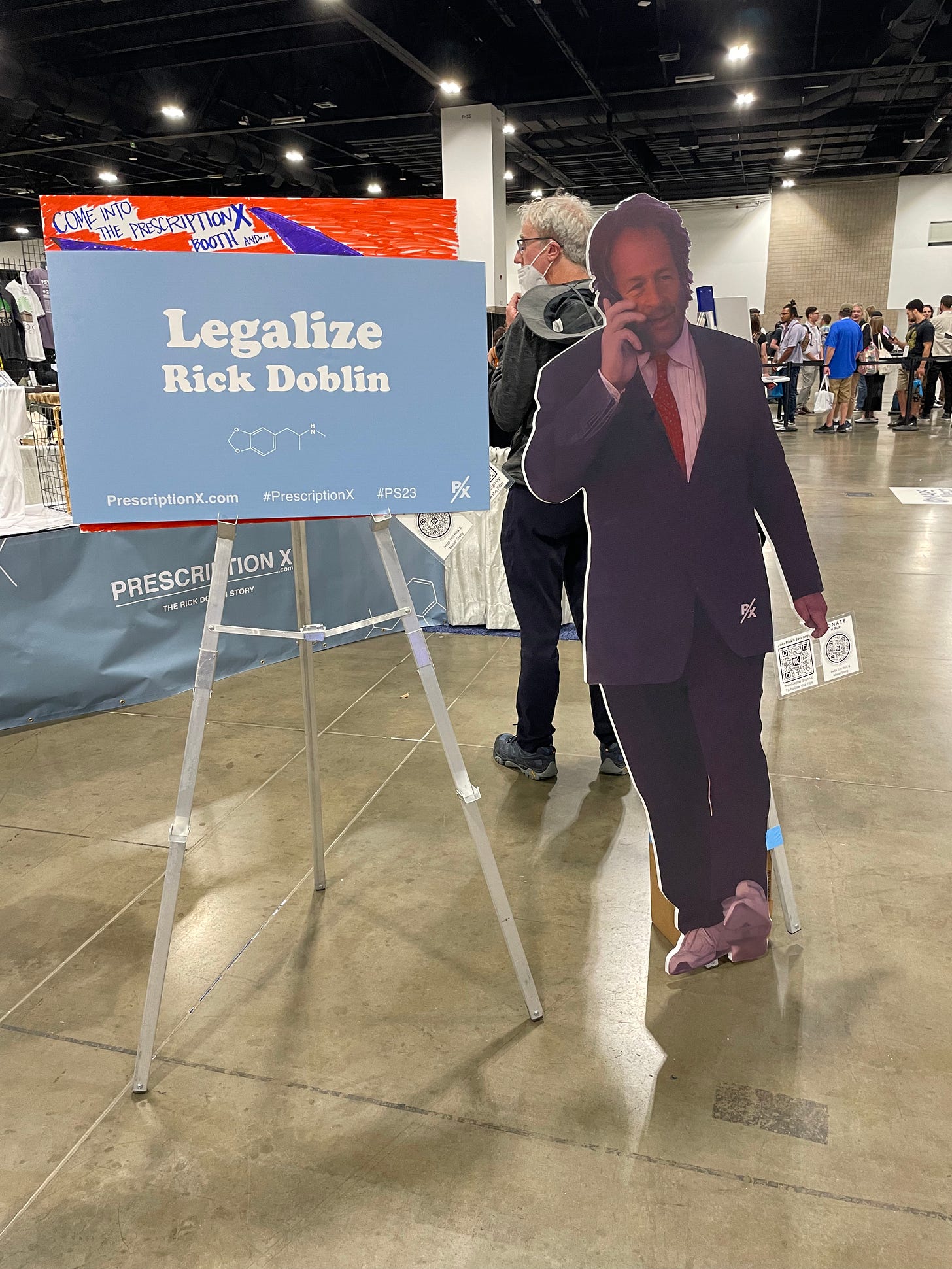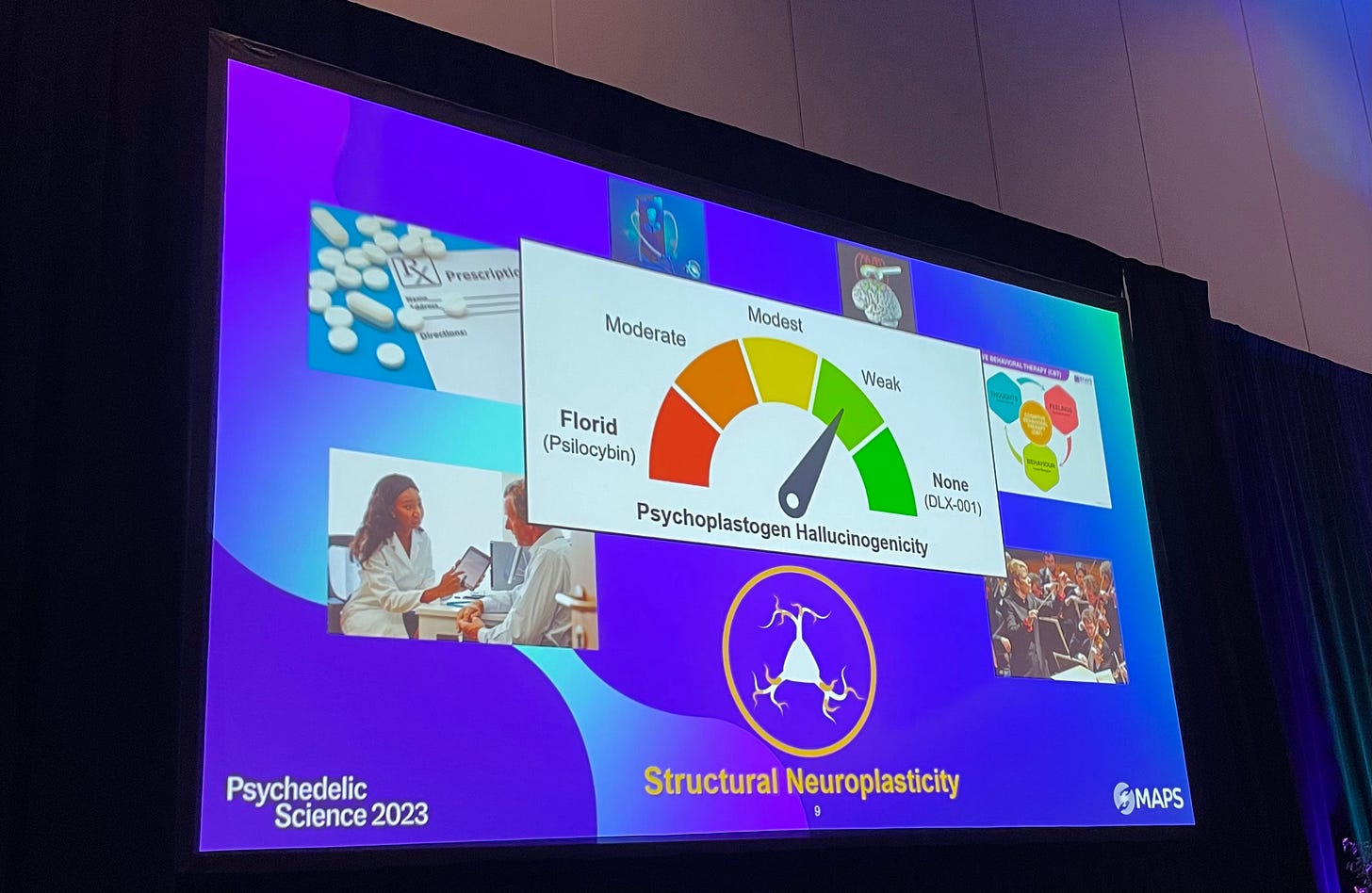Welcome back to The Microdose, an independent journalism newsletter brought to you by the U.C. Berkeley Center for the Science of Psychedelics. This week, we’ll be bringing you daily dispatches from the Psychedelic Science 2023 conference in Denver.
Question of the Day: Each day I’m asking conference attendees one question. The question today is “What’s your unpopular opinion about psychedelics?” Here’s a sampling of responses.
“When people hear the word ‘mushrooms,’ they don't take it seriously because the party and rave culture around it has given it a negative association.”
Aaron Galindo, psychonaut, Fresno, CA
“People often mistake psychedelics as a cure instead of a tool.”
Alexandra Pales, nurse practitioner at Lakeview Mental Health, Everett, WA
Panel on psychedelic churches and the Religious Freedom Restoration Act (RFRA)
There are four active court cases involving ayahuasca churches in the U.S., and three of the four panelists have served as lawyers in court on behalf of one of them involving The Church of the Eagle and Condor. The religious congregation based in Phoenix, Arizona uses ayahuasca and has sued the U.S. Drug Enforcement Administration over its seizures of the church’s supply in 2020. There are dozens of other churches that also use psychedelics, and panelists offered insights into how the law evaluates what constitutes a religious belief and “compelling interest” to intervene in psychedelic churches. Allison Hoots, an attorney who wrote a guide on best practices for “plant medicine churches” for the non-profit group Chacruna, said that most of her clients haven’t had any contact with the law. “If you’re doing religious work with psychedelics and you’re having no problems with law enforcement, you don’t need to do anything,” said attorney Jack Silver, who is representing The Church of the Eagle and Condor, and who also represented the Santo Daime church in their lawsuits in the late 2000s. In such cases, plaintiffs need to demonstrate “injury” to the court, such as when the government interdicts their supply of psychedelic substances or arrests members for participating in religious practices.
Hoots also encouraged churches to think carefully about what language they use in official documents. “This will all be used for you or against you in litigation,” she said. “Be very clear when you articulate your religious beliefs.” Such language could be used by the government to determine whether a church’s activities constitute a religion with “sincerely held” beliefs. Attorney Martha J. Hartney, who has also advised The Church of the Eagle and Condor, detailed two different standards of “religion” used in the Ninth and Tenth Circuits in the U.S. Court of Appeals. The Ninth Circuit uses an extremely broad definition — “If it feels to the person that it is religious, then it is religious,” said Hartney — while the Tenth Circuit uses something called the Meyers Test, which asks whether the religion has metaphysical beliefs, an ethical or moral system, a church leader and clergy, rituals, clothing, food preferences, and belief in a supreme being. If psychedelic churches sue the government for interfering with their religious rights, Silver recommended involving a theologian who can testify that a church’s practices do, in fact, constitute a religion.
Panelists also discussed what they characterized as the government’s bias against religious institutions that use psychedelics for healing or health purposes. Churches’ petitions to the Drug Enforcement Administration for access to ayahuasca have been denied when the reason appears more related to health than religion, said Silver. Though the government seems to treat religious and medical use of psychedelics as dichotomous, the attorneys on the panel said churches should take some of the same precautions a medical provider might, including screening members for health reasons.
One audience member asked whether panelists knew of any churches that use 5-MeO-DMT, and whether they thought the government would allow such churches. Hoots and Silver said they both had clients whose religious practices include use of that drug, but Hoots noted that only ayahuasca had been tested under the law. “It’s never been done for psilocybin, MDMA, or synthetics but in theory it’s possible,” she said.
Want the latest psychedelics news? Subscribe! (It’s free!)
Presentation on the effects of an ayahuasca ceremony on immigrants and refugees
Matthew X. Lowe, research director of psychedelics non-profit Unlimited Sciences, presented data from a small study investigating how an ayahuasca ceremony affected women immigrants and refugees from Middle Eastern and North African countries. That population often faces higher risks for poor mental health because they face barriers to healthcare and employment, and often have experienced traumatic events, said Lowe. Twelve of the study’s 15 participants had been diagnosed with a mental health condition, and half said they had been “recently bothered by an experience that caused them to believe they would be injured or killed.”
The participants completed surveys about their mental health two weeks prior to the ayahuasca ceremony, and again on the day of the ceremony. After participating in the ayahuasca ceremony, the women received group and individual integration, and researchers conducted follow-up surveys one to three days, two to four weeks, and three to four months post-session. In those surveys, the women reported significantly decreased symptoms of depression and anxiety, and increased emotional reappraisal (the ability to assess or modify an emotional response to a situation) and self compassion, as well as reduced feelings of shame. A few participants reported persisting negative effects — three reported loneliness and two “depressive notions.” Despite that, all but one participant said the ceremony was among the most meaningful experiences of their lives.
The effects these women reported are striking, but more research is needed to understand whether these results might generalize to other groups, and what, exactly, is driving the effects. This was an observational study, not a randomized controlled trial. Lowe mentioned that his team also plans to publish qualitative data about participants’ experiences.
Side Trip: the exhibition hall
The exhibition hall is a maze of comfy-looking couches, colorful banners, and jars of dried mushrooms. Conference sponsors KGK Science + Wellbeing Digital Sciences and Polka Dot Chocolates boasted big, splashy displays, while non-profit organizations like Students for Sensible Drug Policy and Emerge Law Group put up simple booths with paper handouts. Elsewhere, vendors sold holographic art; tinctures to aid bad trips; psychedelic retreats; mushroom growing substrate and fertilizer (best name: PooGod); and trip kits designed to entertain people on MDMA. I saw one particularly long line snaking around a booth selling chocolates. I asked someone who’d just made a purchase if the chocolates actually contained psychedelics. “Yeah,” he said, showing me what looked like a lighter in his hand. “And they got DMT pens, too.” A woman next to us leaned in to tell me she’d just bought some MDMA gummies.
I even made a niche celebrity sighting while I was there: psychedelic artist Alex Grey, who created MAPS’ logo, stood for pictures with fans in front of a portrait of Roland Griffiths looking saintly. (Griffiths is a Johns Hopkins researcher often credited with bringing psychedelic research back into the mainstream.) The piece was displayed in a frame with phrases like “ineffable spirit” and “transcendence of time and space.” Grey unveiled the portrait on Wednesday night at a dinner held in Griffith’s honor.
Just outside the main exhibition hall, a booth advertising a documentary about Rick Doblin’s life included a life-size cutout of Doblin along with merch emblazoned with the phrase “Legalize Rick Doblin.” Next to that was the official MAPS merch table, where I overheard one volunteer asking the others for their guesses on Doblin’s age. One guessed 67, another 72. (The real answer: 69.) The booth’s offerings made it clear that 90s fashion is back: there were tie-dye fanny packs and bucket hats with phrases like “psychedelic science” and “be the bridge.”
Presentation on the potential of non-hallucinogenic psychedelics
Delix Therapeutics is perhaps the biggest name in the development of drugs that have similar chemical structures to classic psychedelics but with hallucinogenic effects removed. The company’s chief science officer Kurt Rasmussen called these drugs “third generation psychedelic compounds,” or psychoplastogens. He claimed that the therapeutic effects of psychedelics could be split from the hallucinations, and that these new drugs work by tweaking receptors in the brain “to take advantage of the brain’s innate ability to heal itself.” Rasmussen acknowledged that many people believe that part of classic psychedelics’ power lies in the trip, but he claims that the trip is unlikely to be necessary for all therapeutic uses. He gave the example of psilocybin’s potential in treating migraine and cluster headaches. “What would ego dissolution do for migraines?” he asked.
On Tuesday, Delix announced they’d completed a phase I trial of their psychoplastogen DLX001, which was completed in the Netherlands. Participants were safe and healthy, Rasmussen said, and reported no hallucinations, so the company will continue their studies by testing an increased dose. Rasmussen concluded his presentation by giving his view of the future of psychedelics. “I see a day where patients suffering from different disorders with different symptoms, or even the same disorder, can be treated with hallucinogenic or non hallucinogenic drugs,” he said.
A correction: In yesterday's issue, we misquoted attorney Brett Waters about his views on federal reform. What he actually said is that after observing what's happened in the cannabis movement, it's a common misconception that seeking federal reform for psychedelics is "a waste of time," when in fact there have been promising steps at the federal level including the the Breakthrough Therapies Act, which could lead to the rescheduling of psychedelics. We regret the error.
Have a great day — we’ll be back in your inbox tomorrow with more from the conference.
If you know anyone who might like the latest on psychedelics in their inbox, feel free to forward this to them, or click below.
Got tips? Email us at themicrodose@berkeley.edu.













For those of us unable to attend for one reason or another, it's good to have a small window into the event. A more detailed and comprehensive overview or summary would have been ideal, but for that you'd have needed a full staff roaming the venue and attending presentations, which understandably would be a challenge. In any case, it's still a valuable porthole into an important event. Thanks!
Thank you for featuring our Unlimited Sciences study🙏